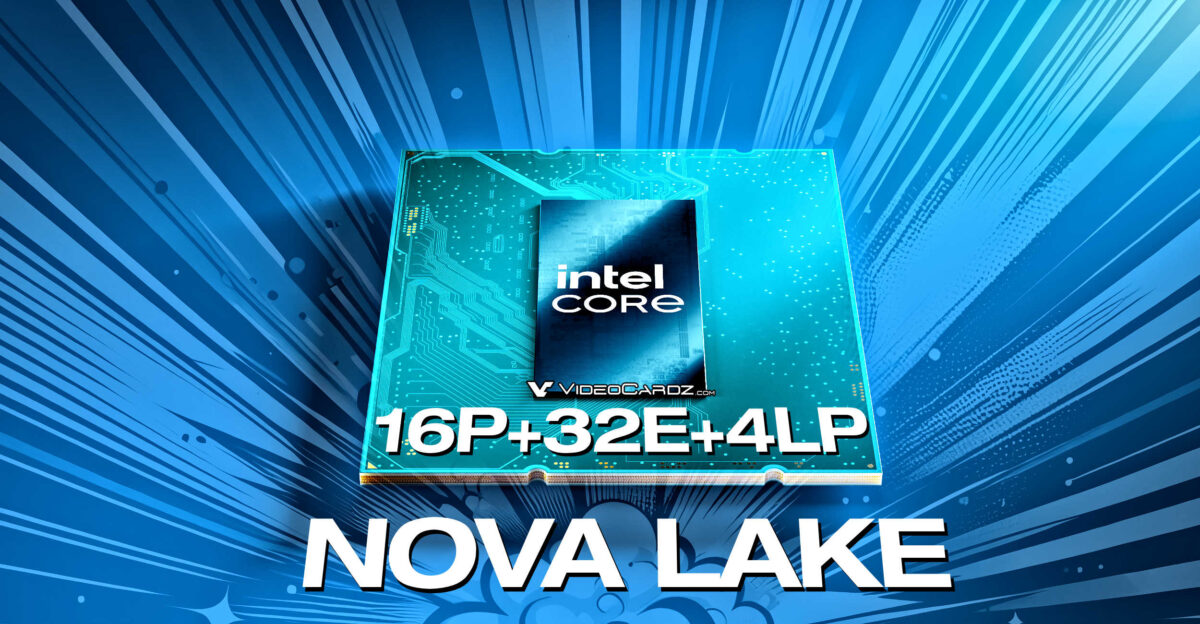Intel appears to be gearing up for a major comeback in the gaming CPU arena – next-generation Nova Lake processors may include a massive 144 MB L3 cache architecture, codenamed Big Last-Level Cache or bLLC, targeted specifically at gaming and latency-critical workloads.
For years, AMD maintained dominance in gaming performance with its 3D V‑Cache chips, especially the Ryzen X3D series. Intel struggled with Arrow Lake desktop CPUs, where gaming frame rates and single-core performance lagged behind. A cache-heavy Nova Lake SKU with up to eight P‑cores and 16 E‑cores could tilt the balance back toward Intel, especially if priced competitively.
Rumors suggest that flagship Nova Lake CPUs may not include the large bLLC; instead, select 8-core configurations will carry the bLLC specialization. Combined with a 125 W TDP, these variants are meant to appeal to gamers who value lower latency over sheer multi-threaded throughput. If realized, 144 MB of cache would exceed AMD’s current 128 MB X3D limit and could boost performance in simulation-heavy titles, physics computations, and dynamic world rendering.
Set to arrive in late 2026 as Part of Intel’s Core Ultra 400 lineup, Nova Lake aims to redefine expectations. Intel is betting on reclaiming trust with gamers, many of whom felt let down by past architectural transitions and performance gaps, and this cache-first approach might deliver.
What Nova Lake Means for PC Gaming
For gamers, Nova Lake isn’t just another chip – it’s a potential game-changer. With improved IPC, better thermal management, and AI-driven performance balancing, Nova Lake promises smoother gameplay, faster load times, and reduced power consumption.
If paired with next-gen GPUs, it could finally eliminate bottlenecks that plague high-end setups. Competitive players might benefit from improved input latency and faster frame rendering, while casual users could enjoy cooler, quieter systems. This leap could also give laptop gamers desktop-level performance without the heat or noise. Nova Lake isn’t hype – it’s the backbone of PC gaming’s near future, and expectations are sky-high.
Why This Matters for Gamers
Intel’s past desktop chips leaned into high core counts and hybrid efficiency, but often at the cost of raw, low-latency gaming performance. The bLLC strategy offers a direct response: bigger cache, tighter data pipelines, and less reliance on memory fetches.
In gaming, the difference is real. City-building sims, open-world multiplayer titles, and competitive shooters are extremely cache-sensitive, especially when it comes to draw calls and AI simulation. A larger L3 cache means faster logic cycles and potentially better frame pacing in CPU-heavy scenes.
Intel may also price the gaming-focused variants aggressively, leaning into value per performance rather than high-core workstation pricing. That makes this pivot not just technical, but tactical: targeting AMD’s strengths with its own edge.
Potential Pitfalls
That said, bLLC will likely be limited to certain Nova Lake SKUs – probably lower-core 8‑P‑core models. Flagship chips with 16 performance cores and 32 efficiency cores may skip the large cache, favoring scale instead.
Users may also require a new socket – rumored to be LGA 1954 – which could mean motherboard upgrades. And while Intel’s cache boost is compelling, AMD’s 3D stacking method still offers a proven real-world performance advantage. Execution matters: poor thermal design or binning decisions could diminish gains.
What Comes Next
Stay tuned through late 2025 and early 2026 as leaks solidify and benchmarks emerge. Intel likely has Arrow Lake refresh models slated for late 2025, followed by the full Core Ultra 400 rollouts around mid‑2026.
The focus on bLLC hints at renewed rivalry between Intel and AMD, but also signals potential benefits for consumers. Gaming‑centric CPUs with cache-rich architecture could catalyze innovation across the market and herald better competition in pricing.

